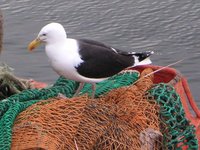Great Black-backed Gull
|
|
| Great Black-backed Gull | ||||||||||||||
|---|---|---|---|---|---|---|---|---|---|---|---|---|---|---|
 | ||||||||||||||
| Scientific classification | ||||||||||||||
| ||||||||||||||
| Binomial name | ||||||||||||||
| Larus marinus (Linnaeus, 1758) |
The Great Black-backed Gull, Larus marinus, is a very large gull which breeds on the European and North American coasts and islands of the North Atlantic. It is fairly sedentary, but some birds move further south or inland to large lakes or reservoirs.
This species breeds singly or in small colonies, making a lined nest on the ground often on top of a rocky stack. 3-5 eggs are laid..
This is the largest gull, much bigger than a Herring Gull. It is 61-74 cm long with a 1.4 to 1.7 m wingspan. It is bulky, and has a powerful bill. The adults have black wings and back, with conspicuous white "mirrors" at the wing tips. The legs are pinkish, and the bill yellow with a red spot.
Young birds have scaly black-brown upperparts, and a neat wing pattern. They take four years to reach maturity. The call is a deep "laughing" cry.
These are omnivores like most Larus gulls, and they will scavenge as well as seeking suitable small prey. They frequently rob other seabirds of their catch.de:Mantelmöwe et:Merikajakas eo:Nigramantela mevo fr:Goéland marin ja:オオカモメ nl:Grote mantelmeeuw pl:Mewa siodłata
